-
二叉树相关OJ - C++
根据二叉树创建字符串
题目:
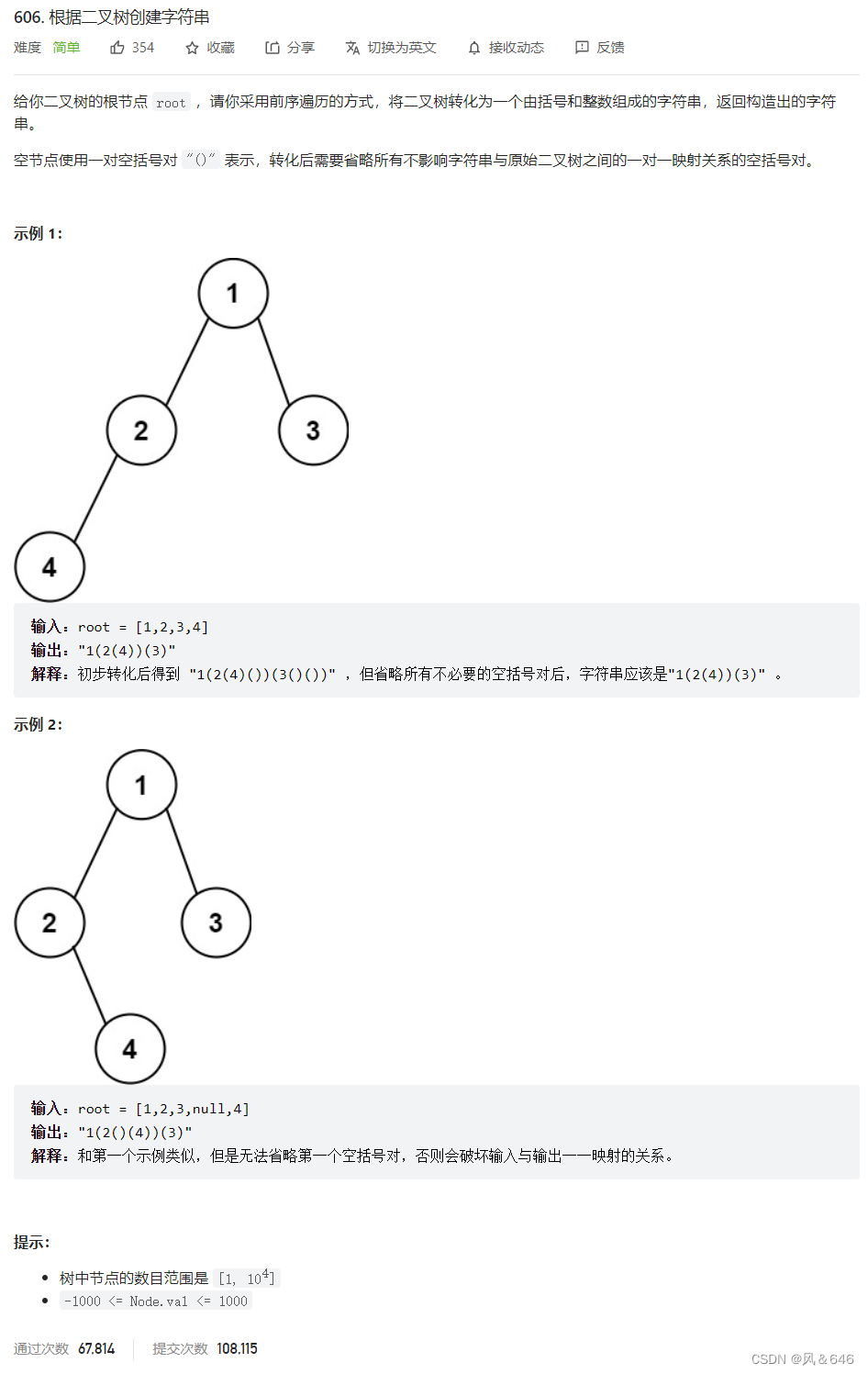
分析:此题我们可以递归创建字符串,只是递归的时候需要注意什么时候需要加括号或者不加括号。这题的节点数据使用 to_string 函数转换成字符串。
1、节点左右子树都为空时,或者右子树是空树时,括号省略掉。
2、左子树为空,右子树不为空,则括号不能省略。注意:此题中,我们使用子函数进行递归创建字符串,str使用传引用接收,减少拷贝从而增加效率。
题解:
class Solution { public: // 使用传引用接收,减少拷贝,提高效率 void _tree2str(TreeNode* root,string& str) { // 树为空 if(root==nullptr) return; // str加上节点数据转出的字符串 str+=to_string(root->val); // 递归左子树创建字符串 if(root->left) // 左子树不为空 { str+='('; _tree2str(root->left,str); str+=')'; } else if(root->right) // 左子树为空,但右子树不为空 { str+="()"; } // 递归右子树创建字符串 if(root->right) // 右子树不为空 { str+='('; _tree2str(root->right,str); str+=')'; } } string tree2str(TreeNode* root) { string str; _tree2str(root,str); return str; } };- 1
- 2
- 3
- 4
- 5
- 6
- 7
- 8
- 9
- 10
- 11
- 12
- 13
- 14
- 15
- 16
- 17
- 18
- 19
- 20
- 21
- 22
- 23
- 24
- 25
- 26
- 27
- 28
- 29
- 30
- 31
- 32
- 33
- 34
- 35
- 36
- 37
- 38
- 39
二叉树的层序遍历
题目链接:leetcode102.二叉树的层序遍历
题目:
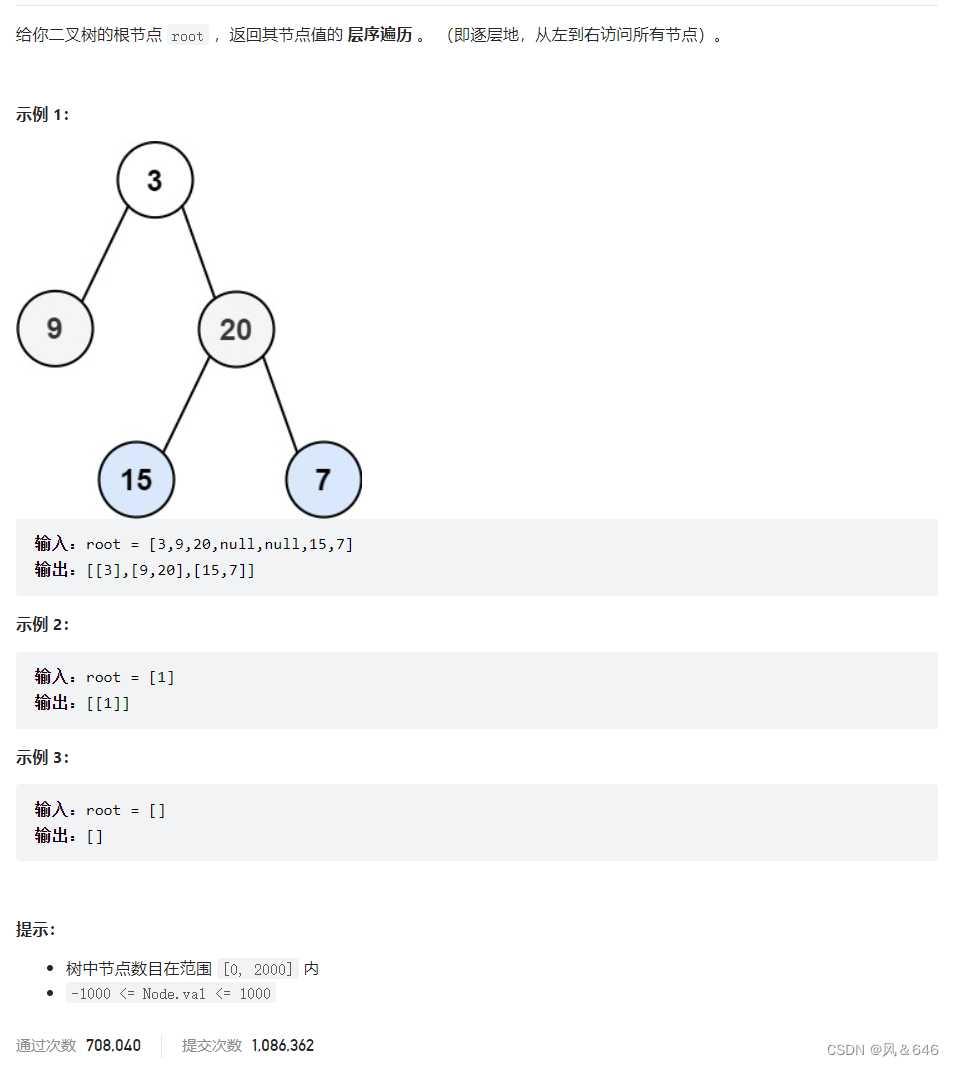
分析:
用 levelSize 标记每一层节点的数量,每出一个节点,就将当前所出节点的左右节点尾插到队列中,直到队列为空则二叉树遍历完成。

题解:class Solution { public: vector<vector<int>> levelOrder(TreeNode* root) { vector<vector<int>> vv; // 若二叉树为空,则返回一个空的匿名对象 if(root==nullptr) return vector<vector<int>>(); //return vv; // 定义一个队列,用来存储二叉树的节点 queue<TreeNode*> q; // 将第一层如队列 int levelSize=1; q.push(root); // 队列不为空,则表明二叉树结点没有出完,直到为空则遍历完成 while(!q.empty()) { // 存储每一层的数据 vector<int> v; while(levelSize--)// 控制当前层的数据出完 { // 取出队头结点,并将其数据尾插到v中 TreeNode* front=q.front(); q.pop(); v.push_back(front->val); // 将该结点的左右结点入队列(该节点左节点或右节点不为空) if(front->left) q.push(front->left); if(front->right) q.push(front->right); } vv.push_back(v); // 上一层出完了,下一层都入队列了,当前队列的数据个数就是下一层的数据个数 levelSize=q.size(); } return vv; } };- 1
- 2
- 3
- 4
- 5
- 6
- 7
- 8
- 9
- 10
- 11
- 12
- 13
- 14
- 15
- 16
- 17
- 18
- 19
- 20
- 21
- 22
- 23
- 24
- 25
- 26
- 27
- 28
- 29
- 30
- 31
- 32
- 33
- 34
- 35
- 36
- 37
- 38
- 39
- 40
二叉树的最近公共祖先
题目:
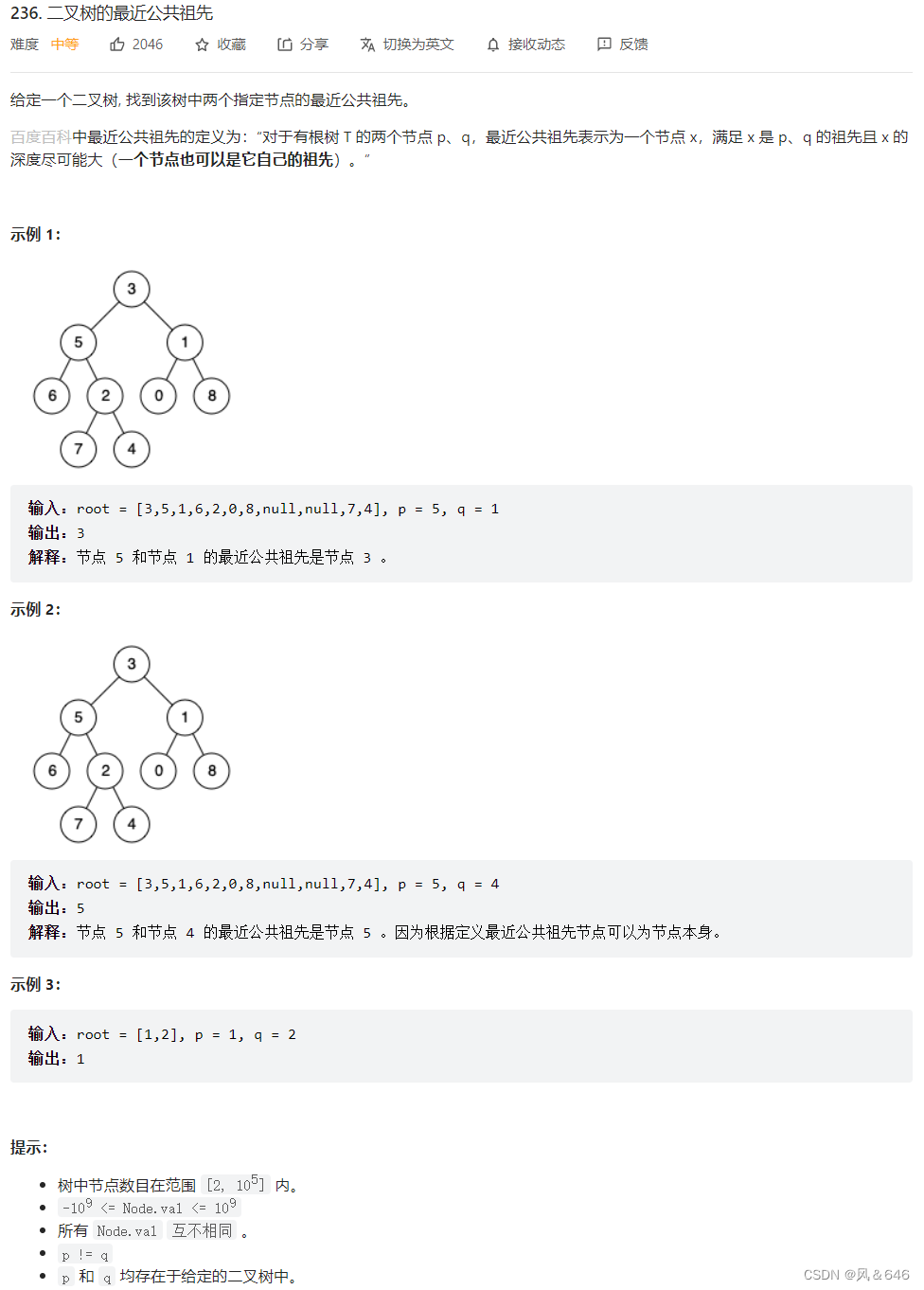
分析:
除了最后一种情况,p和q中本身有一个节点就是最近公共祖先,除此之外,p和q两个节点一定分别在最近公共祖先节点的左右两侧。

题解:class Solution { public: bool find(TreeNode* root,TreeNode* x) { if(root==nullptr) return false; if(root==x) return true; return find(root->left,x)||find(root->right,x); } TreeNode* lowestCommonAncestor(TreeNode* root, TreeNode* p, TreeNode* q) { // p节点或q节点为当前根节点,则它就是最近公共祖先 if(q==root||p==root) return root; // 确定p和q节点在当前节点的左子树还是右子树 bool pInLeft,qInLeft,qInRight,pInRight; // 因为p和q一定在二叉树中,所以p和q节点不是在根节点左边,那么就是在根节点右边 pInLeft=find(root->left,p); pInRight=!pInLeft; qInLeft=find(root->left,q); qInRight=!qInLeft; // p和q节点都在当前根节点左边,则递归左子树继续查找 if(pInLeft&&qInLeft) return lowestCommonAncestor(root->left,p,q); // p和q节点都在当前根节点右边,则递归右子树继续查找 else if(pInRight&&qInRight) return lowestCommonAncestor(root->right,p,q); // p和q节点在当前节点的左右两侧,则当前节点即是最近公共祖先 else return root; } };- 1
- 2
- 3
- 4
- 5
- 6
- 7
- 8
- 9
- 10
- 11
- 12
- 13
- 14
- 15
- 16
- 17
- 18
- 19
- 20
- 21
- 22
- 23
- 24
- 25
- 26
- 27
- 28
- 29
- 30
- 31
- 32
- 33
- 34
- 35
- 36
- 37
- 38
- 39
- 40
上面的解法在一些特殊的情况下就是比较慢,时间复杂度最坏可达到O(N^2),因此我们需要对其进行优化处理,如下介绍第二种方法。
1、可将此题转化为链表相交问题,用两个栈分别记录根节点到p和q的路径。
2、让分别记录p和q的栈种长度较大的那个先走差距步。
3、然后一起走,直到找到相同的节点即使他们的最近公共祖先。递归左右子树,遇到节点就入栈,入当前节点的左右子树均没有目标节点,则该节点出栈,最终栈里面的就是p或q到根节点路径上的节点。

题解:class Solution { public: bool FindPath(TreeNode* root,TreeNode* x,stack<TreeNode*>& path) { // 空树,直接返回 if(root==nullptr) return false; // 将当前节点入栈,然后与要查找的节点进行对比 path.push(root); if(root==x) return true; // 若在左子树或者右子树中找到了待查找节点,就返回true if(FindPath(root->left,x,path)) return true; if(FindPath(root->right,x,path)) return true; // root不是要找的结点x,左子树和右子树都没有找到,那么root不是x的路径中结点 path.pop(); return false; } TreeNode* lowestCommonAncestor(TreeNode* root, TreeNode* p, TreeNode* q) { // 查找p和q的路径,存储在对于的栈中 stack<TreeNode*> pPath,qPath; FindPath(root,p,pPath); FindPath(root,q,qPath); // 让长的那个栈先走差距步 while(pPath.size()<qPath.size()) { qPath.pop(); } while(qPath.size()<pPath.size()) { pPath.pop(); } // 两个栈同时走,并取栈顶元素对比,若两个栈栈顶元素相等,则栈顶元素就是最近公共祖先 while(pPath.top()!=qPath.top()) { pPath.pop(); qPath.pop(); } // 返回任意一个栈的栈顶元素 return qPath.top(); } }- 1
- 2
- 3
- 4
- 5
- 6
- 7
- 8
- 9
- 10
- 11
- 12
- 13
- 14
- 15
- 16
- 17
- 18
- 19
- 20
- 21
- 22
- 23
- 24
- 25
- 26
- 27
- 28
- 29
- 30
- 31
- 32
- 33
- 34
- 35
- 36
- 37
- 38
- 39
- 40
- 41
- 42
- 43
- 44
- 45
- 46
- 47
- 48
- 49
- 50
- 51
- 52
二叉搜索树与双向链表
题目链接: 牛客JZ36.二叉搜索树与双向链表
题目:

分析:
使用中序遍历,定义一个cur指针指向当前中序遍历的结点,prev指向cur的前一个结点,如图所示:第一次cur指向二叉树的最左节点,prev指向空。为了将节点用原有的指针排序成一个双向链表,cur的左指针指向prev,prev的右指针指向cur。

题解:class Solution { public: // 这里的prev使用传引用接收,让全程只有一个prev, // 若用传值接收,则递归时另外一层栈帧中prev的改变不影响上一层 void InorderConvert(TreeNode* cur,TreeNode*& prev) { // 当前节点为空,直接返回 if(cur==nullptr) return; InorderConvert(cur->left, prev); // 当前节点的左指针指向前驱节点,若前驱节点不为空,则前驱节点的右指针指向当前节点 cur->left=prev; if(prev) prev->right=cur; // 向后递归之前,先更新前驱节点 prev=cur; InorderConvert(cur->right, prev); } TreeNode* Convert(TreeNode* pRootOfTree) { // 为空树的情况 if(pRootOfTree==nullptr) return nullptr; // 定义一个前驱节点 TreeNode* prev=nullptr; InorderConvert(pRootOfTree,prev); // 寻找头节点 TreeNode* head=pRootOfTree; while(head->left) { head=head->left; } return head; } };- 1
- 2
- 3
- 4
- 5
- 6
- 7
- 8
- 9
- 10
- 11
- 12
- 13
- 14
- 15
- 16
- 17
- 18
- 19
- 20
- 21
- 22
- 23
- 24
- 25
- 26
- 27
- 28
- 29
- 30
- 31
- 32
- 33
- 34
- 35
- 36
- 37
- 38
- 39
- 40
从前序与中序遍历序列构造二叉树
题目链接: leetcode105.从前序与中序遍历序列构造二叉树
题目:

分析: 根据前序序列可以确定出二叉树的根,找到根在中序遍历中所处的位置,可确定树的左子树和右子树区间,然后根据前序和中序递归创建二叉树。
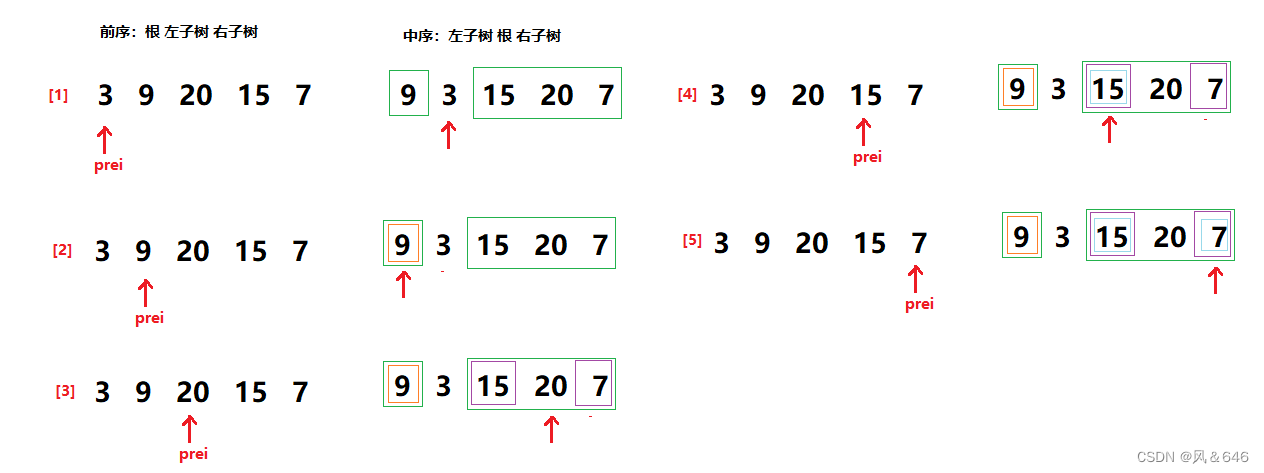
题解:class Solution { public: TreeNode* _buildTree(vector<int>& preorder,int& prei,vector<int>& inorder,int inBegin,int inEnd) { // 区间不符合规范,返回nullptr if(inBegin>inEnd) return nullptr; // 创建根节点 TreeNode* root=new TreeNode(preorder[prei]); ++prei; // 划分中序的左右子区间 int rooti=inBegin; while(rooti<=inEnd) { if(root->val==inorder[rooti]) break; else ++rooti; } // 递归构建左右子树 // [inBegin,rooti-1] [rooti] [rooti+1,inEnd] root->left=_buildTree(preorder,prei,inorder,inBegin,rooti-1); root->right=_buildTree(preorder,prei,inorder,rooti+1,inEnd); return root; } TreeNode* buildTree(vector<int>& preorder, vector<int>& inorder) { int prei=0,inBegin=0,inEnd=inorder.size()-1; return _buildTree(preorder,prei,inorder,inBegin,inEnd); } };- 1
- 2
- 3
- 4
- 5
- 6
- 7
- 8
- 9
- 10
- 11
- 12
- 13
- 14
- 15
- 16
- 17
- 18
- 19
- 20
- 21
- 22
- 23
- 24
- 25
- 26
- 27
- 28
- 29
- 30
- 31
- 32
- 33
- 34
- 35
从中序与后序遍历序列构造二叉树
题目链接:leetcode106.从中序与后序遍历序列构造二叉树
题目:
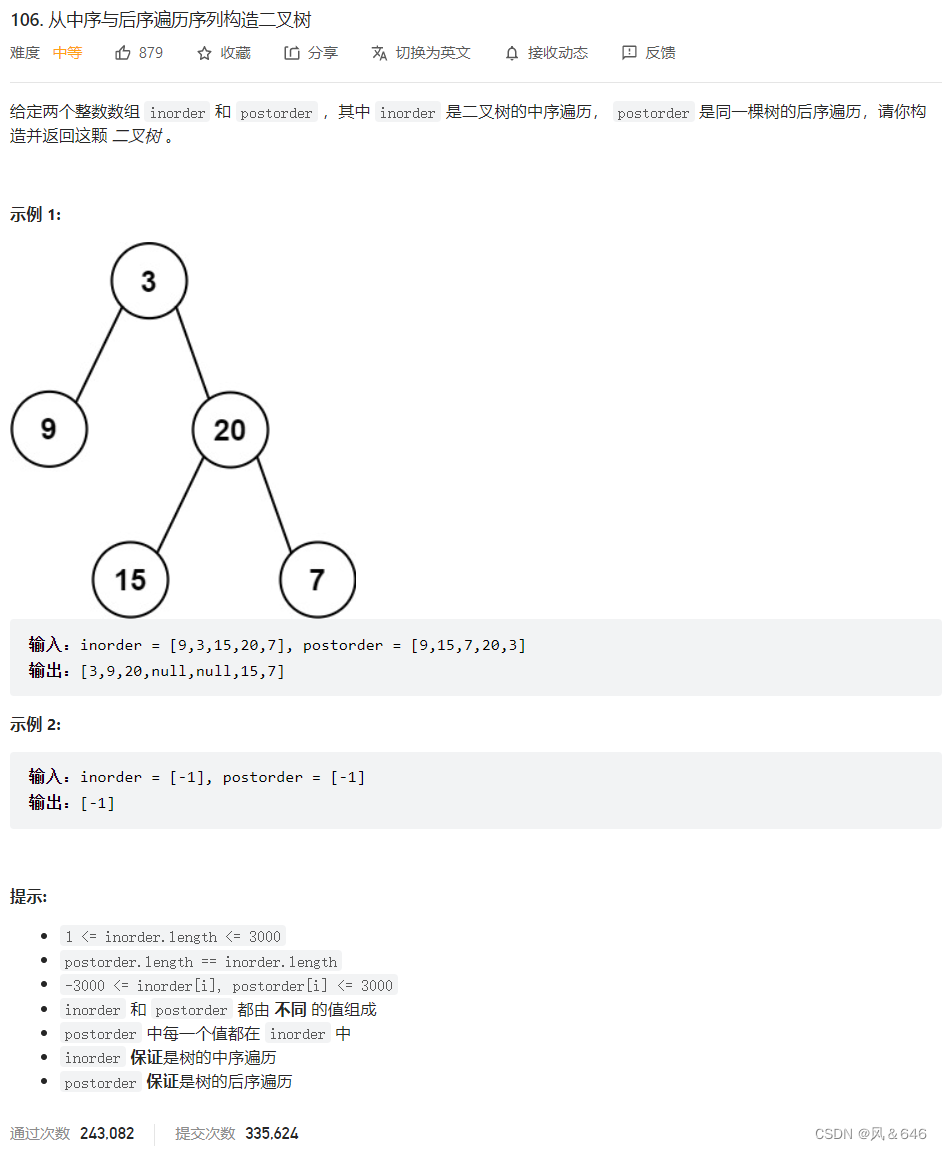
分析: 此题和上面一题是类似的,思路相同,只是按照后序来确定根。题解:
class Solution { public: TreeNode* _buildTree(vector<int>& postorder,int& posti,vector<int>& inorder,int inBegin,int inEnd) { // 递归区间不符合规范,返回nullptr if(inBegin>inEnd) return nullptr; // 创建根节点 TreeNode* root=new TreeNode(postorder[posti]); --posti; // 划分中序遍历中该节点的左右子区间 int rooti=inBegin; while(rooti<=inEnd) { if(root->val==inorder[rooti]) break; else rooti++; } // 先递归创建右子树,再递归创建左子树 root->right = _buildTree(postorder,posti,inorder,rooti+1,inEnd); root->left = _buildTree(postorder,posti,inorder,inBegin,rooti-1); return root; } TreeNode* buildTree(vector<int>& inorder, vector<int>& postorder) { int posti=postorder.size()-1,inBegin=0,inEnd=inorder.size()-1; return _buildTree(postorder,posti,inorder,inBegin,inEnd); } };- 1
- 2
- 3
- 4
- 5
- 6
- 7
- 8
- 9
- 10
- 11
- 12
- 13
- 14
- 15
- 16
- 17
- 18
- 19
- 20
- 21
- 22
- 23
- 24
- 25
- 26
- 27
- 28
- 29
- 30
- 31
- 32
- 33
- 34
二叉树的前序遍历(非递归)
题目链接:leetcode144.二叉树的前序遍历
题目:

分析:前序遍历: 根 左子树 右子树
非递归遍历一棵树:
- 左路节点
- 左路节点的右子树 – 子问题

题解:class Solution { public: vector<int> preorderTraversal(TreeNode* root) { stack<TreeNode*> s; vector<int> v; TreeNode* cur=root; while(!s.empty()||cur) // cur指向哪个节点就表示前序访问这棵树 { // 遍历左路节点,左路节点入栈 -- 访问一棵树的开始 while(cur) { v.push_back(cur->val); s.push(cur); cur=cur->left; } // 依次去栈中取左路节点的右子树来访问 TreeNode* top=s.top(); s.pop(); // 访问左路节点的右子树 -- 转化为子问题 cur=top->right; } return v; } };- 1
- 2
- 3
- 4
- 5
- 6
- 7
- 8
- 9
- 10
- 11
- 12
- 13
- 14
- 15
- 16
- 17
- 18
- 19
- 20
- 21
- 22
- 23
- 24
- 25
二叉树的中序遍历(非递归)
题目链接: leetcode94.二叉树的中序遍历
题目:
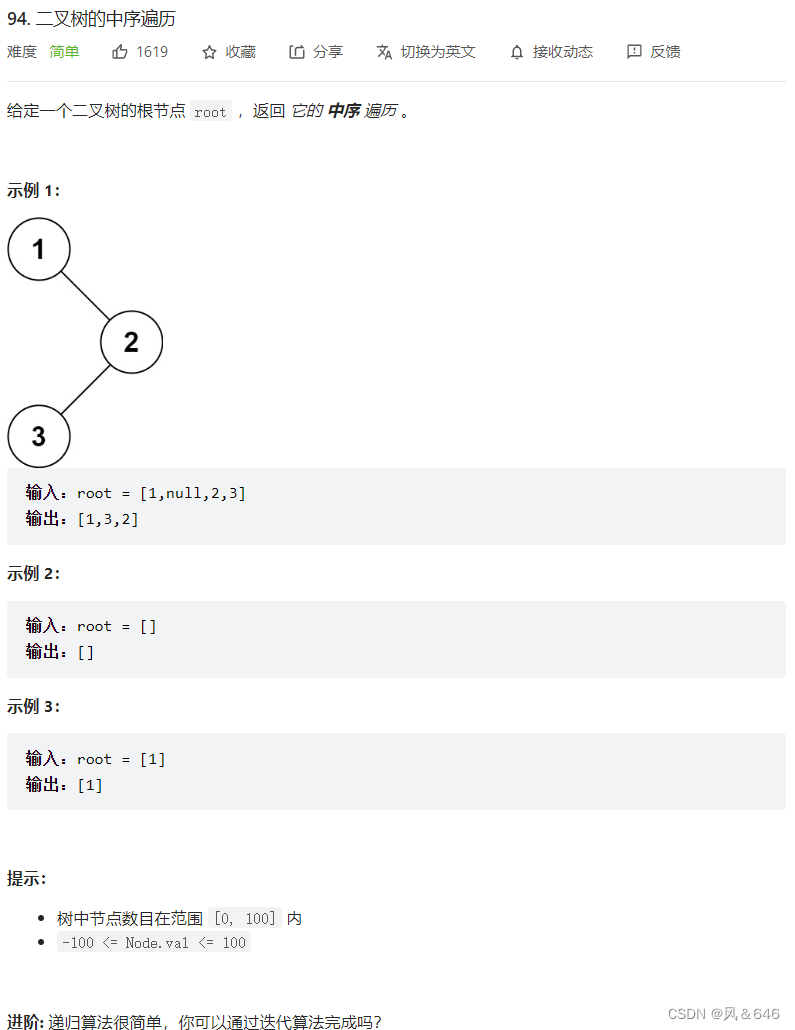
分析:中序遍历:左子树 根 右子树
与上题类似,只是根节点的访问需要它的左子树已访问完,因此当前数据在当前节点左子树访问完成之后出栈。
题解:
class Solution { public: vector<int> inorderTraversal(TreeNode* root) { stack<TreeNode*> s; vector<int> v; TreeNode* cur=root; while(!s.empty()||cur) // cur指向哪个节点就表示前序访问这棵树 { // 左路节点入栈 while(cur) { s.push(cur); cur=cur->left; } // 依次取栈中左路节点,这时表示这个节点的左子树已经访问完了, // 先访问它,再以子问题的形式去访问它的右子树 TreeNode* top=s.top(); s.pop(); v.push_back(top->val); // 子问题的形式去访问这棵右子树 cur=top->right; } return v; } };- 1
- 2
- 3
- 4
- 5
- 6
- 7
- 8
- 9
- 10
- 11
- 12
- 13
- 14
- 15
- 16
- 17
- 18
- 19
- 20
- 21
- 22
- 23
- 24
- 25
- 26
- 27
- 28
二叉树的后序遍历(非递归)
题目链接:leetcode145.二叉树的后序遍历
题目:
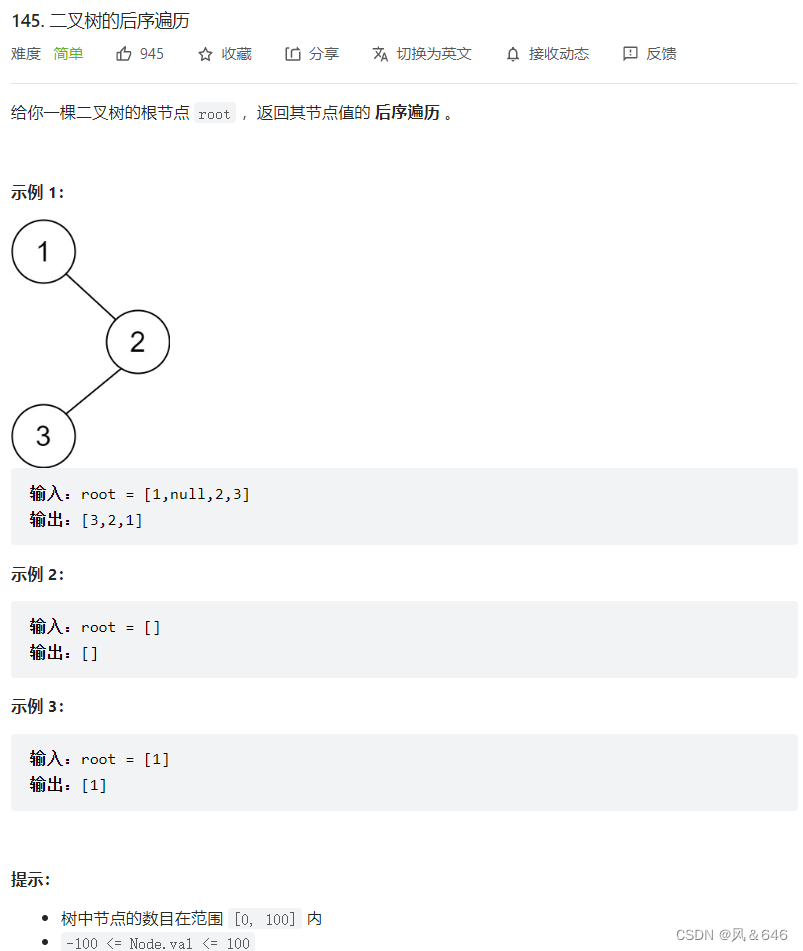
分析:
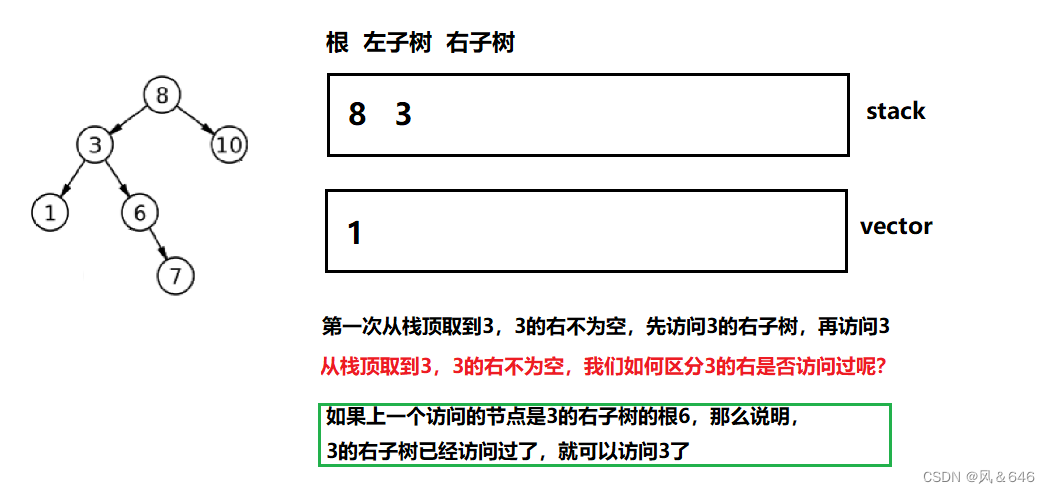
题解:class Solution { public: vector<int> postorderTraversal(TreeNode* root) { vector<int> v; stack<TreeNode*> st; TreeNode* prev=nullptr; TreeNode* cur=root; while(!st.empty()||cur) { // 左路节点保存到栈 while(cur) { st.push(cur); cur=cur->left; } // 取到一个栈顶元素,说明它的左路节点已经访问完了 // 如果它的右为空,或者右子树已经访问完了(上一个访问的节点是top的右子树),那么就可以访问栈顶元素了 TreeNode* top=st.top(); if(top->right==nullptr||top->right==prev) { v.push_back(top->val); prev=top; st.pop(); } // top->right!=nullptr,且右子树还没有访问,子问题迭代访问 else { cur=top->right; } } return v; } };- 1
- 2
- 3
- 4
- 5
- 6
- 7
- 8
- 9
- 10
- 11
- 12
- 13
- 14
- 15
- 16
- 17
- 18
- 19
- 20
- 21
- 22
- 23
- 24
- 25
- 26
- 27
- 28
- 29
- 30
- 31
- 32
- 33
- 34
-
相关阅读:
【HTML】web worker
Visio免费版!Visio国产平替软件,终于被我找到啦!
自定义npm包混淆过滤发布至nexus私服
536、RabbitMQ详细入门教程系列 -【消息与队列进阶 RabbitMQ(二)】 2022.07.29
Docker安装与部属
电流继电器HDL-A/1-110VDC-1
25G LWDM与25G MWDM光模块的区别对比
springboot 使用 microsoft SQL server 报错
【大模型LLM面试合集】大语言模型架构_MoE经典论文简牍
公司要招个程序员,34岁以上两年一跳的不要,开出工资以为看错了
- 原文地址:https://blog.csdn.net/qq_61939403/article/details/127870899
